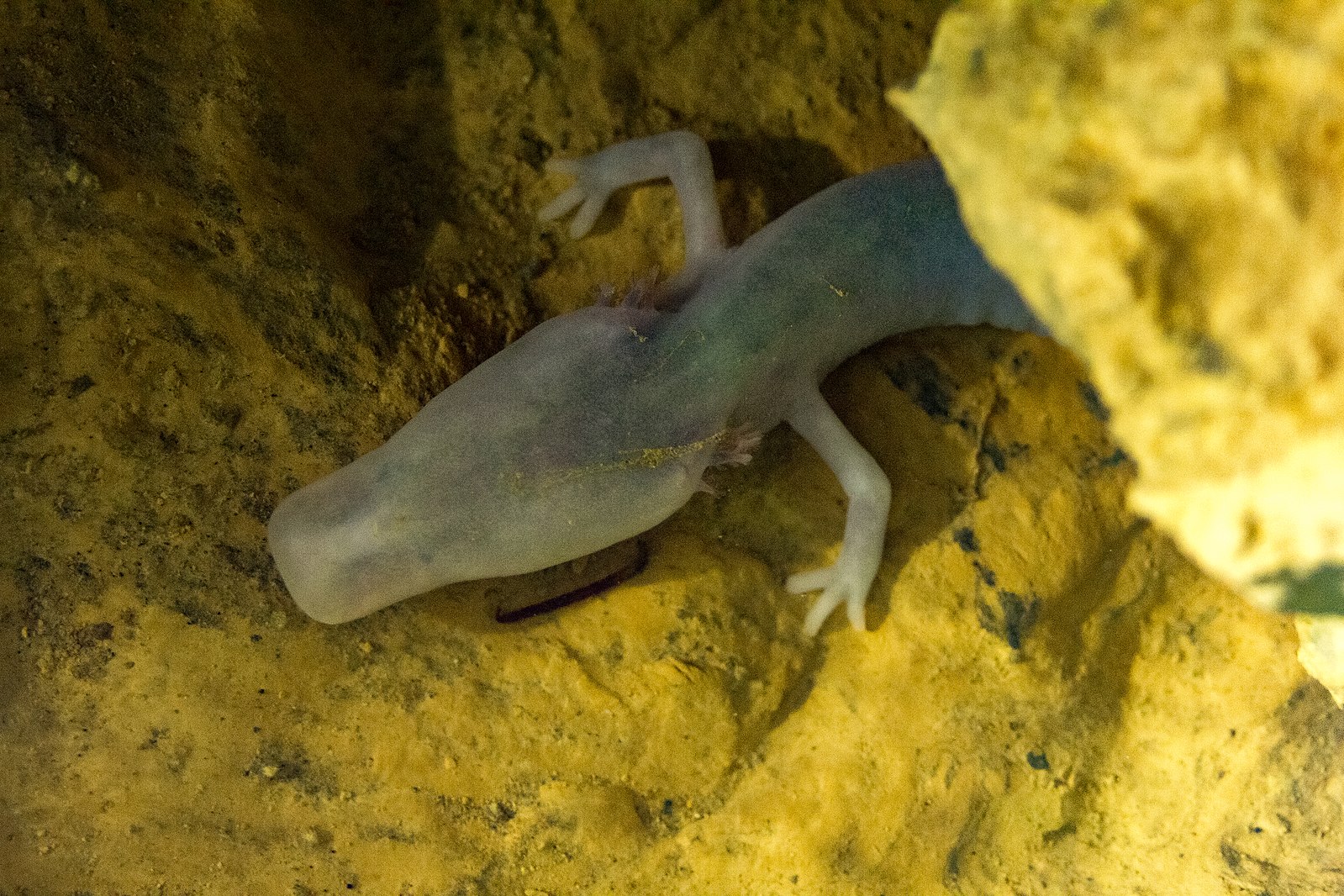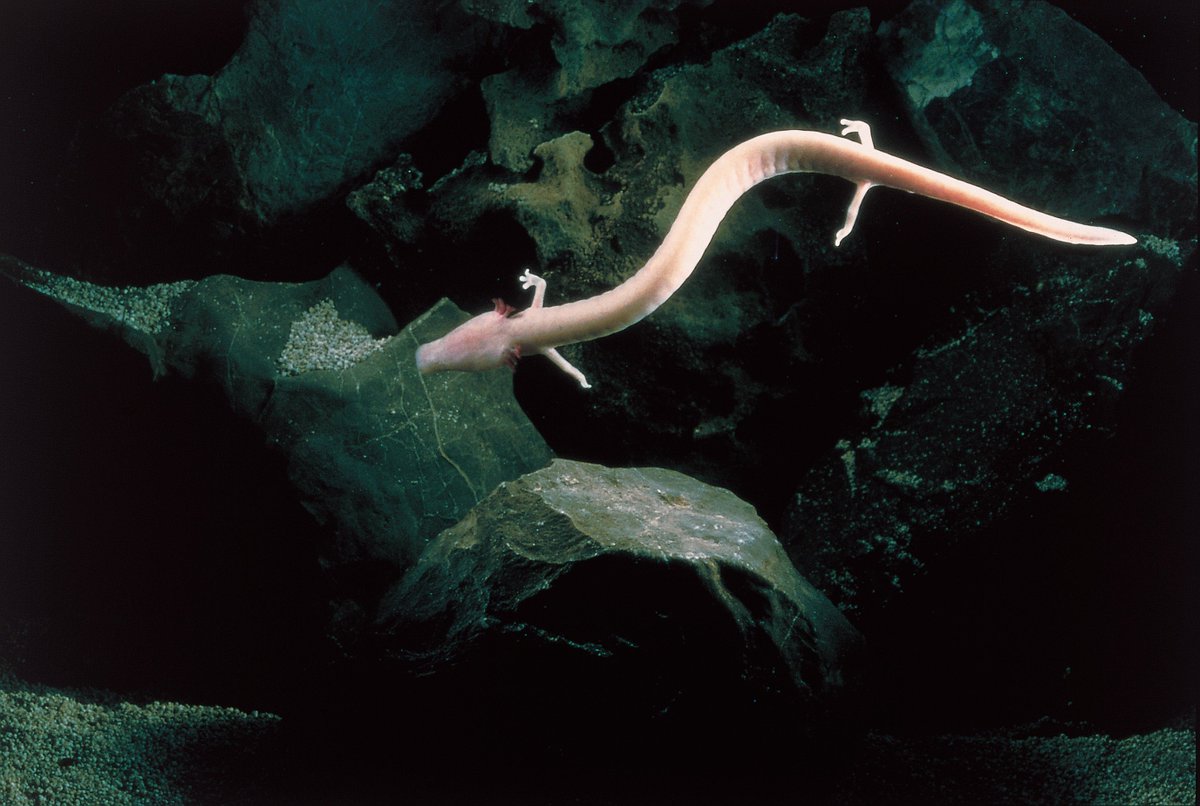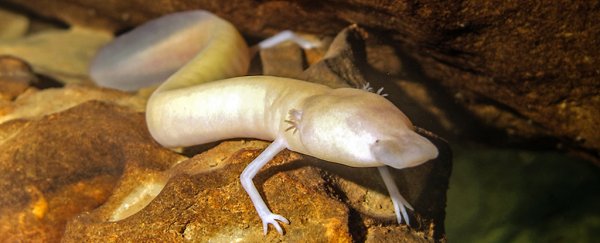In the depths of a European cave, dwells what must be the laziest and most underwhelming of all creatures to have ever been called a dragon. With disturbingly fleshy-coloured skin, it has also earned the label of "human fish".
But the olm (Proteus anguinus), with its cute stubby limbs, is actually an amphibian - a type of salamander that has adapted to life in the eternal darkness of a skyless existence. This troglobite lifestyle has resulted in under-developed eyes covered by layers of skin, which led Charles Darwin to refer to the species as "wrecks of ancient life".
Olm eyes can only detect the presence of light, but not much else. Thus, these little gill-adorned weirdos are essentially blind, but they make up for this with a keen sense of smell, underwater hearing, and the ability to detect movements in their watery home.
Between 2010 and 2018, researchers captured, tagged, and recaptured a number of olms in the caves of eastern Bosnia-Herzegovina. Based on the frequency of their encounters, they estimated there were 26 adult olms making themselves at home there; across these eight years, checking in on their research subjects revealed the animals had a rather limited movement range.
"The majority of recaptured individuals moved less than 10 metres (33 feet) during several years," wrote zoologist Gergely Balázs from Eötvös Loránd University and colleagues in their paper.
One of these individuals was even lazier than the rest. It was found in the exact same spot a crazy 2,569 days after it was first recorded. That's over seven years! But there are clues in olm biology that might explain this seemingly unbelievable feat.
 (Javier Ábalos Alvarez/Flickr/CC BY SA 2.0)
(Javier Ábalos Alvarez/Flickr/CC BY SA 2.0)
These little slackers have a lifespan of up to a century. For such slight creatures, up to 20 grams (0.7 ounces) and 30 centimetres long (12 inches), that's an impressive feat, so clearly they're doing something right.
"They are hanging around, doing almost nothing," Balázs told New Scientist.
This may be key to their longevity - the olms' strategy of primarily doing diddly-squat has been working well for them since they colonised caves around 20 million years ago.
Olms are able to achieve these epic heights of laziness thanks to a very low metabolism. They eat snails and crustaceans (which aren't exactly plentiful in the caves), but can survive for years without food.
The lack of predators within their cave systems would also encourage their couch potato ways, allowing olms to be perfectly safe just plonking themselves wherever.
Additionally, they only bother to breed about every 12 years. But when they do, they produce a clutch of around 35 of these spectacular looking eggs.
And it's not like they can't move - some olms have easily fled from nosy scientists, by wiggling their way through tens of metres of water. Nor can the scientists say for sure that their tagged subjects didn't go for a wonder while they weren't looking, before sneaking back to their favourite position.
 (Arne Hodalič/Wikimedia Commons/CC BY-SA 3.0)
(Arne Hodalič/Wikimedia Commons/CC BY-SA 3.0)
But Balázs and colleagues found this group of olms has very low genetic diversity, suggesting the population recently shrunk, or has a high level of inbreeding, which again hints at a very sedentary life. A previous study suggested only their young might be dispersing.
This lack of genetic diversity was not found in Slovenian olm populations, so further research is required to see if the incredibly slow-paced lifestyle of the recently studied population is shared by the rest of the species.
"We can only speculate that animals feeding on a very low food supply, reproducing sporadically and living for a century are very energy cautious and limit their movements to the minimum," the researchers wrote.
Biologist Matthew Niemiller of the University of Alabama, who was not involved in the study, agrees. He told Science News:
"If you're a salamander trying to survive in this … food-poor environment and you find a nice area to establish a home or territory - why would you leave?"
In this fast-paced, stressed-out world, perhaps we should all aspire to be a bit more like these olms.
This research was published in the Journal of Zoology.
You may also enjoy this:
Or this: